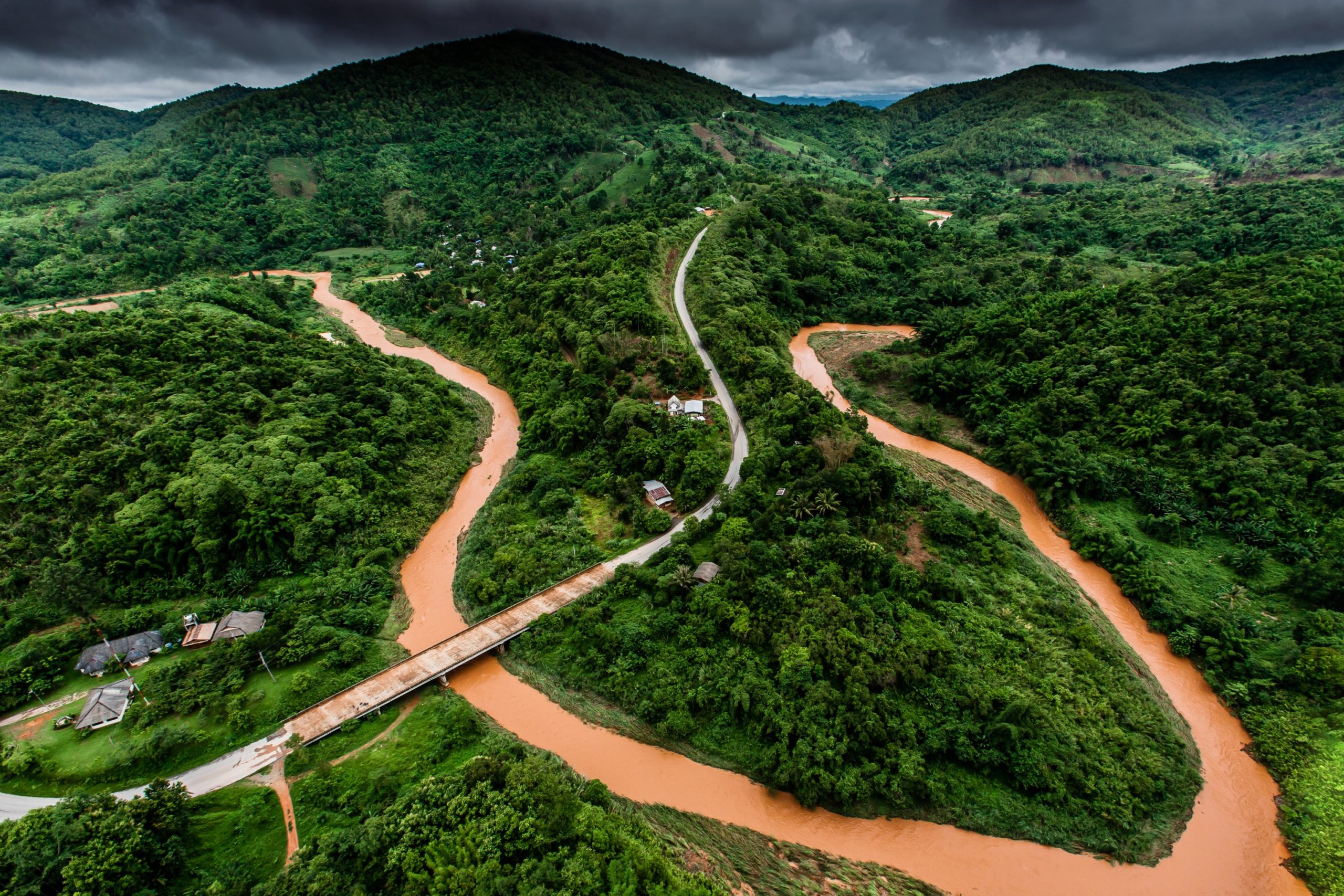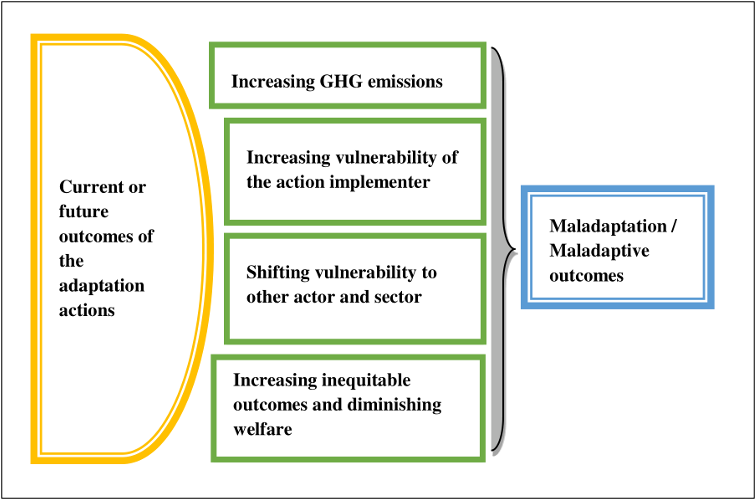
Maladaptation refers to the negative consequences of adaptation actions that can increase current or future vulnerability to climate change. While the importance of adaptation to climate change and mitigation initiatives is well-recognized in the agricultural sector, maladaptation has not received sufficient attention. A recently published systematic review of adaptation by farmers (Datta, Behera, and Rahut 2022) highlights that maladaptation is still under-researched in the Indian context, and further studies have supported this finding for other countries as well (Neset et al. (2019) and Guodaar et al. (2020)).
Figure 1: Maladaptive Outcomes
 Source: Adapted from Juhola et al. (2015) and IPCC (2022).
Source: Adapted from Juhola et al. (2015) and IPCC (2022).
Why does maladaptation remain under-researched?
The analytical concept of maladaptation has only been developed recently
Despite being a major concern in this era of climate change, the concept of maladaptation remained theoretically underdeveloped and lacked an analytical framework until October 2015, when Juhola et al. (2015) attempted to redefine and remove the elusiveness of maladaptation by providing an analytical and operational concept. Since then, research documenting the maladaptive outcomes of agricultural adaptation strategies has begun to grow, but the number of empirical investigations has still not risen to a level to stimulate sufficient research in this field.
Much focus is on assessing adaptation to climate change and mitigation pathways
Agriculture is largely recognized as a climate-sensitive sector that requires adaptation to sustain global food security while simultaneously requiring mitigation strategies to keep greenhouse gas emissions in check. As a result, research on farmers’ perceptions of climate change, adaptation strategies, and their determinants for facilitating adaptation policy initiatives is widespread in the existing literature (Shaffril et al. 2018; Aryal et al. 2021; Datta, Behera, and Rahut 2022; Rahut et al. 2021). Several studies have also examined the mitigation options (Tesfahun 2018; Calvin et al. 2021). Maladaptation may have been ignored so far because of the pressing need to facilitate adaptation and mitigation.
Maladaptation may take time to become visible and could vary over space
The negative consequences of adaptation might take a long time to manifest. Migration and livelihood diversification are increasingly being reported as adaptation measures in various Asian countries (Shaffril, Krauss, and Samsuddin 2018; Aryal et al. 2021). However, farmers may lose their cultural identity as a result of migration, and some indigenous knowledge systems and traditional diets may disappear over time as unintended consequences of adaptation. Furthermore, if farmers’ livelihood options diversify, they may devote less attention to producing crops, and in certain situations, they may abandon agriculture (Datta, Behera, and Rahut 2020). These consequences may eventually reduce the number of farmers, posing several challenges for the agricultural production system. Therefore, maladaptive outcomes might take a long time to appear on a larger scale and may vary across space, making them difficult to identify.
Maladaptation largely depends on subjective judgment
Maladaptation can be extremely subjective, and it might even be overlooked when both the positive and negative consequences are associated with an adaptation measure. Migration can have a range of negative consequences, but it can also have positive outcomes in certain places. For example, migration can increase household income while making migrant families more climate resilient (Jha et al. 2017). It can also enhance women’s empowerment, food security, and access to education and health care (Singh, Singh, and Kumar 2013). As a result, determining when adaptation becomes maladaptive is highly subjective.
Is there a way forward?
While maladaptation is largely plagued with the problems of spatiotemporality and subjective judgment, more studies are required to develop baseline data on both the actual and potential maladaptive outcomes. Further, this data should be refined by identifying which adaptation outcomes are desired and to what extent local communities can bear the negative outcomes that might come with some benefits. In this context, stakeholder-based participatory approaches should be prioritized by ensuring the utmost involvement of the locals. The empirical evidence of maladaptation obtained in this way can effectively inform decision-makers about the risks associated with adaptation measures and help them plan accordingly. Moreover, the growth in studies addressing maladaptation can drive forward the current debate on the subject and enhance its conceptual development.
References
Aryal, J. P., T. B. Sapkota, D. B. Rahut, P. Marenya, and C. M. Stirling. 2021. Climate Risks and Adaptation Strategies of Farmers in East Africa and South Asia. Scientific Reports 11(1): 1–14.
Calvin, K., A. Cowie, G. Berndes, A. Arneth, F. Cherubini, J. Portugal-Pereira, G. Grassi, J. House, F. X. Johnson, A. Popp, and M. Rounsevell. 2021. Bioenergy for Climate Change Mitigation: Scale and Sustainability. GCB Bioenergy 13(9): 1346–1371.
Datta, P., B. Behera, and D. B. Rahut. 2022. Climate Change and Indian Agriculture: A Systematic Review of Farmers’ Perception, Adaptation, and Transformation. Environmental Challenges.
Guodaar, L., F. Asante, G. Eshun, K. Abass, K. Afriyie, D. O. Appiah, R. Gyasi, G. Atampugre, P. Addai, F. and Kpenekuu. 2020. How Do Climate Change Adaptation Strategies Result in Unintended Maladaptive Outcomes? Perspectives of Tomato Farmers. International Journal of Vegetable Science 26(1): 15–31.
IPCC. 2022. IPCC Sixth Assessment Report. IPCC.
Jha, C. K., V. Gupta, U. Chattopadhyay, and B. A. Sreeraman. 2017. Migration as Adaptation Strategy to Cope with Climate Change: A Study of Farmers’ Migration in Rural India. International Journal of Climate Change Strategies and Management.
Juhola, S., E. Glaas, B. O. Linnér, and T. S. Neset. 2015. Redefining Maladaptation. Environmental Science & Policy 55: 135–140.
Neset, T. S., L. Wiréhn, N. Klein, J. Käyhkö, and S. Juhola. 2019. Maladaptation in Nordic Agriculture. Climate Risk Management 23: 78–87.
Rahut, D. B., J. P. Aryal, and P. Marenya. 2021. Understanding Climate-Risk Coping Strategies among Farm Households: Evidence from Five Countries in Eastern and Southern Africa. Science of the Total Environment 769: 145236.
Shaffril, H. A. M., S. E. Krauss, and S. F. Samsuddin. 2018. A Systematic Review on Asia’s Farmers’ Adaptation Practices towards Climate Change. Science of the Total Environment 644: 683–695.
Singh, K. M., R. Singh, and A. Kumar. 2013. Male Worker Migration and Women Empowerment: The Case of Bihar, India. India (30 August 2013).
Tesfahun, W. 2018. Effects of Biochar in Soil Chemical and Biological Property and Mitigating Climate Change. Civil and Environmental Research 10(1).









Comments are closed.